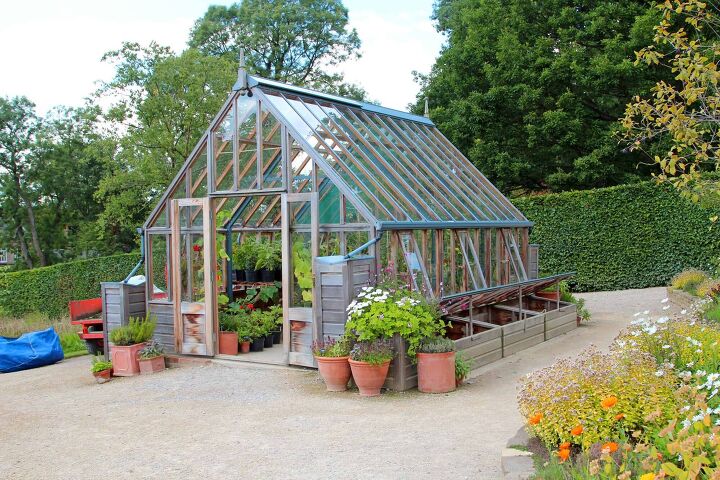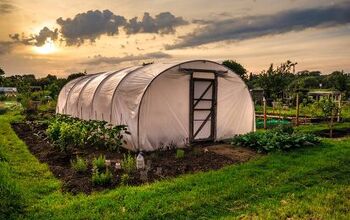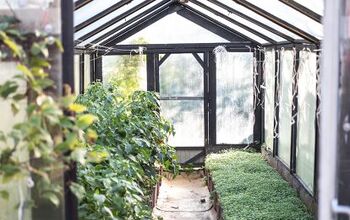How Warm Will A Greenhouse Stay In The Winter?

A greenhouse is the best bet for many plant enthusiasts to keep their green friends alive during the winter. A greenhouse promises that it creates a bubble of sorts for plants to thrive despite the outside temperature. So, how warm will a greenhouse stay in the winter?
A greenhouse can stay up to 30 degrees warmer during the winter. The temperature inside of a greenhouse can still fall below freezing if the outside temperature is below zero. You can increase the temperature retention in a greenhouse if you improve the insulation with horticultural bubble wraps and recycled polystyrene boxes.
Greenhouses are the perfect investment for homeowners that don’t want to sacrifice their plants during the winter. You can ensure that your greenhouse stays warm enough during the winter if you beef up the insulation. Follow along as we explore how warm a greenhouse will stay in the winter.
Do You Need to Hire Greenhouse Builders?
Get free, zero-commitment quotes from pro contractors near you.

Will a Greenhouse Stay Warm Enough in the Winter?
A greenhouse will generally stay warm enough in the winter to sustain plant life. It all comes down to external temperature because greenhouses can stay up to 30 degrees warmer inside. The heat stays within the greenhouse if you keep it sealed which can help plants survive.
However, the temperature can still drop below freezing in a greenhouse if it is extremely cold outside. Sub-zero external temperatures can cause the temperature in your greenhouse to fall below freezing. This is uncommon unless you live in a climate with extremely cold fall and winter seasons.
How to Keep a Greenhouse Warm in the Winter
The best way to keep a greenhouse warm in the winter is to maximize the sunlight. There are several ways to boost the warmth in your greenhouse ranging from special covers to space heaters. Let’s take a look at the best ways to keep a greenhouse warm in the winter.
Sunlight
Sunlight is the key to keeping a greenhouse warm in the winter. The sun is still present during the winter whether it’s cold outside or not, and you need to use it to your advantage. Place your greenhouse in a location that gets plenty of sunlight during the daytime.
You may need to prune trees or even cut them down entirely if they block the light to your greenhouse. Anything that blocks the sunlight to your greenhouse can and will lower the temperature within it. Careful planning is important before you build a greenhouse so that you can maximize the sunlight exposure.
Add Thermal Mass
Add thermal mass to your greenhouse to release warm air throughout the night. The nighttime is when it is easiest for the temperature to drop within a greenhouse. You can minimize that if you fill black barrels full of water and place them in your greenhouse.
The barrels will absorb heat from the sun during the day and release it in the greenhouse at night. This will prevent heat loss and even increase the temperature inside during the day. Choose black barrels if possible because they can absorb the most heat.
Compost
Compost is one of the best ways to generate and retain heat within a greenhouse. Chemical reactions occur within compost that raises your greenhouse’s temperature. It may not sound appealing, but you can place a pile of compost in the center of your greenhouse to generate heat.
The ingredients within the compost decompose throughout the day and raise the temperature. This concept is similar to using barrels of water as a thermal mass. Not only will you keep your greenhouse warm in the winter, but you can use the decomposed compost to feed your plants.
Heat-Preserving Covers
No matter how much you’ve done, there will always be some nights that are colder than the others. Therefore, it’s almost always a good idea to cover your green babies up overnight with something as simple as plastic films.
Some common cover materials include:
- Tarp (your camping tarp will work perfectly fine in this situation)
- Horticulture fleece
- Row cover
- Plastic sheet
As long as the material is heat-preserving and light enough so it doesn’t damage the plants, it can be used as a cover. This will work out great as long as you remember to remove them during the day so your plants can breathe.
Use A Germination Mat
Another good way to keep your greenhouse warm enough for winter gardening is using germination mats.
These mats aren’t designed for all purposes but are perfect if you are only trying to get a head start on next year’s gardening projects. For example, if you want to lay seeds down during wintertime so you can have your first round of harvest early.
Germination mats can provide a healthy, warm and encouraging rooting environment so your seeds can grow. This is a much more affordable method compared to heating up the entire greenhouse, especially if you don’t need the whole space for winter.
Get a Heater
Then, of course, there is the ultimate solution. If your power lines are properly laid in the greenhouse, you can definitely put in a heater for winter purposes.
Nowadays, there are space heaters specifically designed for greenhouses. Also, profane heaters are also a good option, especially if you don’t want to run extension cords to the greenhouse.
If you do consider installing heaters to keep your greenhouse warm, make sure you also install some fans. You would want the heated air to be evenly distributed across the entire greenhouse.
How to Insulate a Greenhouse
The most basic heat-preservation method for any greenhouse is insulation. Same with what you would do with your living space, you want to properly insulate the living space for your veggies and flowers as well.
There are a few heat-preserving insulation materials you can choose from:
- Regular or horticultural bubble wraps: believe it or not, bubble wraps are one of the most convenient and efficient insulation materials to keep your greenhouse warm over the winter.
- Plastic bottles: Your old water bottles are perfect as mini cloches.
- Polystyrene boxes: Recycled polystyrene boxes can be used as insulation for trays used for seedlings.
Also, did you know a blanket of snow covering your establishment could actually help with keeping your greenhouse warm?
Check Soil Temperature
In most places across the United States, soil temperature rarely goes over 50 degrees Fahrenheit during the cold months. On the other hand, most vegetation and plants require a minimum soil temperature of 65 degrees to grow.
If you are unable to keep the soil warm for your plants… Sadly, they have a high chance to freeze to death.
The Reason Behind Cold Soil
If you didn’t know, soil temperature increases when the ground absorbs heat from the sunlight. During wintertime, there may only be 5-6 hours of sunlight in a day — much less than what the soil gets in the summer times.
As we can all agree, when nature isn’t enough, manpower comes into place. Since natural sunlight isn’t enough to maintain the desired soil temperature, that’s when a greenhouse that maintains a warm environment becomes critical.
What Can You Grow In An Unheated Greenhouse?
Assuming that you may not want to take these extra steps or spend the extra money, you can always work your vegetable growth around the seasons so that you can still use your greenhouse. If you’re wanting to heat it, you can still use it by growing vegetables that are commonly grown in the wintertime.
Winter Lettuce
Several different types of lettuce thrive better if the environment is colder, such as lamb’s, little gem, and rocket lettuce. They also grow quickly. Harvest when you have bigger leaves growing.
Spinach And Kale
Spinach and kale are great for growing in a greenhouse during wintertime. However, the growth times can vary depending on the weather.
If you’re looking for a great variety of spinach to sow in your unheated greenhouse, then Riccio d’Asti and Merlo Nero are great for this! Also, kale can live through temperatures that plummet near -6C.
Brussels Sprouts
Brussels sprouts take about three months to grow, give or take. Plant them in December and harvest them in March when they’re about one or two inches around.
However, if you’re going to use them in your cooking you need to harvest sprouts that are around the same size.
Potatoes
Potatoes are wonderful to grow during the wintertime, and they’re perfect for winter recipes for stews and soups.
Plus, they grow in abundance so you’ll have plenty to last you when it comes time to harvest. For the best results though, you should fill your container with one part compost and two parts garden soil.
The downside is that potatoes are susceptible to frost so you will need to keep your greenhouse warm if it gets too cold outside.
But if you plant them early in the winter then they’ll be ready for you in March! Still, plenty of time to enjoy Grandma’s potato soup, as well as a nice baked potato and steak!
Do You Need to Hire Greenhouse Builders?
Get free, zero-commitment quotes from pro contractors near you.

Summing It Up
In conclusion, a greenhouse should stay at least 30 degrees above the outside temperature during winter times. If everything is done right, you shouldn’t need to worry about your plants feeling cold or slowing down growth.
The most popular ways to keep a greenhouse warm over winter include adding insulation, creating compost, utilizing sunlight, and even adding a heater directly to the greenhouse.
It is recommended that you at least combine two of the above-mentioned methods to guarantee you have a warm greenhouse over winter, just in case if the weather gets too extreme.
Related Guides

We are a team of passionate homeowners, home improvement pros, and DIY enthusiasts who enjoy sharing home improvement, housekeeping, decorating, and more with other homeowners! Whether you're looking for a step-by-step guide on fixing an appliance or the cost of installing a fence, we've here to help.
More by Upgraded Home Team



























